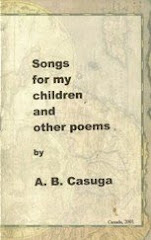07 April 2009
Lesson from translation theory
"The translator is typically faced with the question of whether to modify the world of the text in order to make it accessible to the target culture or whether to attempt to bring the readers toward the culture that produced the text," writes Jeffrey Angles in his description of his course on translation theory at Western Michigan University. We can look at the same question from the point of view of the multilingual writer. The multilingual, multicultural writer is typically faced with the question of whether to dilute the meaning of a word in her/his mother tongue to make it accessible to the target readers (presumed to be monolingual and, sad to say, monocultural) or whether to attempt to bring the readers toward the mother-tongue culture that produced the word. Just as translators have an aesthetic, perhaps even ethical problem every time they face a word without an exact equivalent in the target language, other-language writers, too, have to decide, consciously or subconsciously, whether to distort the mirror to nature that they hold just to make the mother-tongue word comprehensible to the second-language audience. Case in point: Does Bobis' "smothered with coconut milk" capture the way Bicolanos regard coconut milk? In Australian English, even in other varieties of English, "smothered with coconut milk" is a description with no reference to taste or touch but only to sight. Is this a failure of descriptive skill on the part of Bobis or a failure of the English language to achieve unification of sensibility within a word (or words)?
Posted by Isagani R. Cruz at 5:43 AM
Albert B. Casuga said...
One of the staple tools of the fictionist is description; settings, plots, actions, characterisations, conflicts, resolutions all rely on description to build the verisimilitude that the story/narrative aspires to.
The English language appears to have achieved a versatility in limning sensory stimuli and effects, and it relies mainly in combining descriptive words to arrive at a more or less accurate description of sensibilities (sensuous reactions to taste, sight, touch, smell, hearing -- senses that could react distinctly or severally to perceived stimuli.)
For instance, one would describe a meal of steak as "smothered with mushrooms" (covered thickly). Quite another way of understanding the word "smothered" is its way of "killing" or "covering" or "obscuring" another effect.
This immediately invokes the cultural underpinings of the language used in the description. There is no escaping it.
When Bobis described "gingered chicken in green papayas, smothered with coconut milk", only one familiar with the particular cuisine would know whether the "smothering" is a deliberate spiking of the taste of the chicken or a drowning of the otherwise pungent taste of the ginger. The ethnic flavour of the food is captured in the subsequent phrase: "never fails to keep the tongue moist long after the meal is over." Is this the effect of the coconut milk laid on thick on the ginger?
"Tinola" as a chicken dish boiled in rice broth and boiled chicken stock comes to mind. It is likewise "gingered" (boiled with ginger) and cooked with papaya or chayote, and topped with boiled chicken liver. This may no longer be the Spanish/ Mexican "tinola" of colonial times. It may have changed with the culture of the place (could be a tinola in Zamboanga or Cagayan de Oro). But if the same ingredients were boiled with "malungay" leaves, that would make it Ilocano tinola.
Descriptions of gustatory/ visual/ kinaesthetic effects are also common ways of describing food as it stimulates the combined senses.
A language capable of describing "unified" sensory effects would, indeed, be a superior literary medium.
Is Filipino English equipped this way? The writer has only to choose a language that can couch his experience of reality palpably.-- ALBERT B. CASUGA
07 April, 2009 08:19
John Iremil Teodoro Writes "Rediscovering Cecilia Manguerra Brainard"
-
This totally made my day!
https://dailyguardian.com.ph/rediscovering-cecilia-manguerra-brainard/
The writer and academic John Iremil Teodoro wrote about...
1 hour ago











No comments:
Post a Comment